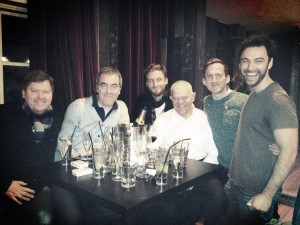 We may be too late for his birthday in New Zealand, but it’s still his day in some parts of the world! Amidst all the hard work going on in New Zealand just now, the Hobbit gang found time to celebrate Ori’s birthday – and co-star Stephen Hunter tweeted this great photo of some of the cast gathered for birthday fun! (After TORn retweeted Stephen’s pic, James Nesbitt and John Callen retweeted us! We’re all connected on one great big web; just like the dwarves in Mirkwood…)
We may be too late for his birthday in New Zealand, but it’s still his day in some parts of the world! Amidst all the hard work going on in New Zealand just now, the Hobbit gang found time to celebrate Ori’s birthday – and co-star Stephen Hunter tweeted this great photo of some of the cast gathered for birthday fun! (After TORn retweeted Stephen’s pic, James Nesbitt and John Callen retweeted us! We’re all connected on one great big web; just like the dwarves in Mirkwood…)
Happy birthday to the dwarf who makes braids and chunky knits look good!
(Photo shows, left to right: Stephen Hunter (Bombur), James Nesbitt (Bofur), Dean O’Gorman (Fili), Mark Hadlow (Dori), Adam Brown (Ori) and Aidan Turner (Kili).)
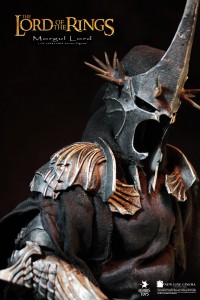 As we excitedly mentioned earlier, the folks at Asmus Toys have acquired a license to make 1:6th figures from The Lord of the Rings. The first figure revealed was the imposing Morgul Lord. Today, we’re pleased reveal this impressive looking figure! The Morgul Lord will stand stand 13.7″ tall, have 36 points of articulation, come with a metal helmet, and a plethora of other items that are going to make for a great figure. You can order the Morgul Lord figure right now from our friends at Alter-Ego Comics for $159.99. The figure is expected to ship in July so place your order today! (Check out the amazing gallery after the break!) [Pre-Order]
As we excitedly mentioned earlier, the folks at Asmus Toys have acquired a license to make 1:6th figures from The Lord of the Rings. The first figure revealed was the imposing Morgul Lord. Today, we’re pleased reveal this impressive looking figure! The Morgul Lord will stand stand 13.7″ tall, have 36 points of articulation, come with a metal helmet, and a plethora of other items that are going to make for a great figure. You can order the Morgul Lord figure right now from our friends at Alter-Ego Comics for $159.99. The figure is expected to ship in July so place your order today! (Check out the amazing gallery after the break!) [Pre-Order]
Continue reading “Collecting The Precious – Asmus Toys Morgul Lord Figure Reveal”
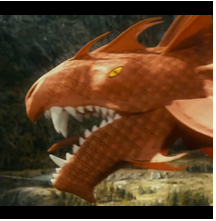
RingerSpy Bruta from The Netherlands shares with us his theory on the appearance of Smaug.
Just like everyone else I’ve been wondering what Peter Jackson’s version of Smaug will look like. There have been a couple of interesting articles by TORn about the appearance and size of the dragon. In TORn’s article ‘Analysis: just how big is Jackson’s Smaug?‘, Demosthenes calculated the size of the drake and Smaug appears to be immense. This is a compelling fact few can deny. Further evidence can be found in the following image of the gate of Erebor .
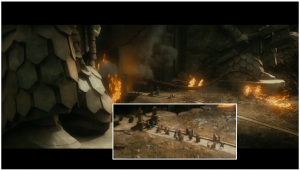
In comparison with Smaug’s tail, the dwarves are about the size of ants. From this it isn’t surprising that in the movie the dwarves are being crushed when Smaug enters through the front gate. In the second TORn article; “Could this be Smaug?!”, Smaug’s head is shown, but to me this is definitely not Smaug, I’ll explain why below.
The Kite theory
In my kite theory, Smaug will have some basic attributes in common with the dragonkite we see the children of Dale flying in the Prologue .
- First: the dragon will indeed be red, his eyes will be yellow, and he will have sharp large front teeth and smaller back teeth.
- Second: the scales on his skin will also be of the same shape and size, as seen on the ‘skin’ of the kite.
- Last and most interestingly: are the similarities that I believe will be shown in the shape of his nose and the number of horns on his head and chin.
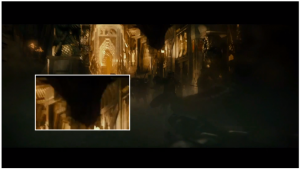
The evidence
If we look at the image, where Smaug pulverizes the dwarves, you can clearly see Smaug’s head. Under the nose and on the sides of his head, you can see his horns. At least, I assume they are horns because that would be the most satisfying explanation for these ‘sticks’. The stick on his nose could also be a tooth, or maybe the end of his kitedragon-like nose. But this isn’t the best picture in which we can see his horned head. When Smaug is swimming in Thror’s gold he dives up, at that moment, in a brief second, the other horns on the top of his head are visible.
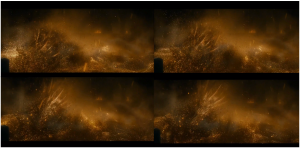
According to my kite theory, Smaug will look something like the kite dragon. When Smaug’s eye is shown we can see some small horns on his head. Based on the picture above we can estimate how many horns this magnificent dragon has. The number of big horns on his head could vary from 5 to 8 or something like that. With this information I searched the web to get the most accurate and satisfying picture of Smaug’s head, as it would look in accordance with my kitedragon theory.
Peter Jackson’s first hint of the dragon?
I think there are similarities between the dragon and the kite, mainly because they came from the same people or group, with the same style, who are creating the look of this creature. So, working on this theory, it can’t be a coincidence that the dragon and the kite would be similar. Alongside of this, the kite may have been made as some sort of illustration of the real dragon as a “visual backstory”, to show that its existence has been handed down in legend amongst the people of Dale and as such would be another reason why there are so many similarities between the two.
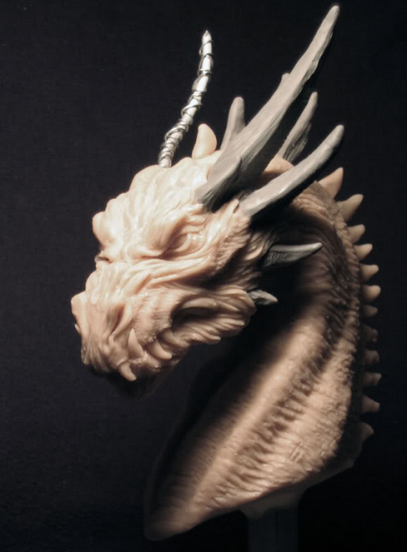
The kite can, in this way, serve as a hint for the viewer because they do not get to see the real dragon yet. The audience only gets quick glimpses of the dragon, small signs of the creature, like wings, claws, feet and then at the end of the movie a potentially large spoiler: Smaug’s eye. From this perspective it isn’t unreasonable to surmise that Peter Jackson chose to show the kite in the Prologue of the movie as another type of teaser/spoiler. Because in the Prologue, we haven’t really seen anything of the dragon yet! It could be the first sign.
Of course, until the release of Desolation of Smaug, this will only be a theory, time will tell. One thing is certain though, Smaug is going to be awesome!
Bruta is a psychology student from The Netherlands, who first discovered Tolkien in 2000 and has been hooked ever since. The views in this article are his own, and do not necessarily represent those of TheOneRing.net or its staff.
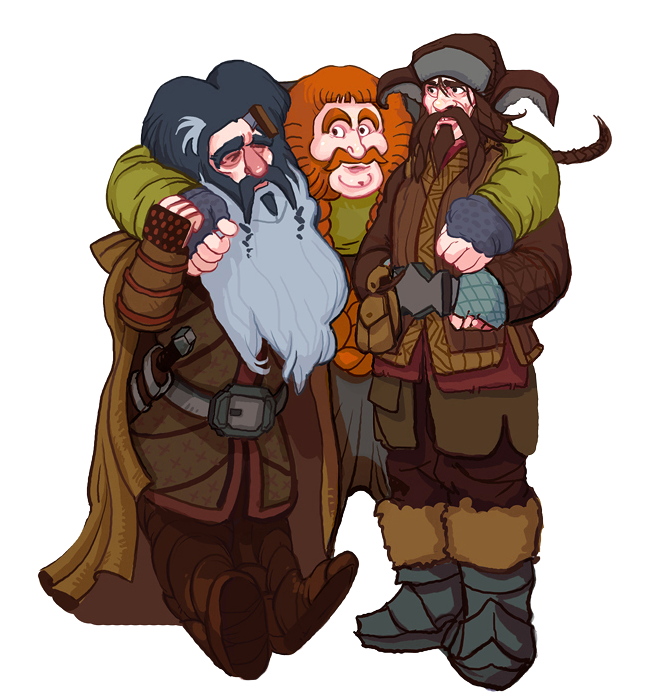 Welcome to our weekly live webcast — TORn TUESDAY — now on the 5th part of our ongoing series of discussions on the History of the Dwarves who undertake the Quest of Erebor. Today we talk about BIFUR, BOFUR and the immensely overweight and endearing BOMBUR (Go #TeamBombur on Twitter!). Bring your questions and join us LIVE for a fascinating chat about how these characters are all intertwined. Continue reading “BIFUR, BOFUR & BOMBUR Dwarven History Part 5 on TORn TUESDAY *Live* Webcast!!”
Welcome to our weekly live webcast — TORn TUESDAY — now on the 5th part of our ongoing series of discussions on the History of the Dwarves who undertake the Quest of Erebor. Today we talk about BIFUR, BOFUR and the immensely overweight and endearing BOMBUR (Go #TeamBombur on Twitter!). Bring your questions and join us LIVE for a fascinating chat about how these characters are all intertwined. Continue reading “BIFUR, BOFUR & BOMBUR Dwarven History Part 5 on TORn TUESDAY *Live* Webcast!!”
If you have a Tolkien/Middle-earth inspired poem you’d like to share, then send it to poetry@theonering.net. One poem per person may be submitted each month. Please make sure to proofread your work before sending it in. TheOneRing.net is not responsible for poems posting with spelling or grammatical errors.
In his third article for our worldwide community, Tedoras, long-time audience participant on our TORn TUESDAY webcast, shares unique insights on the strange demarcation found in The Hobbit but not mentioned in LOTR: the “Edge of the Wild.” Wondering as we often do what exactly Professor Tolkien meant by this invisible line that other characters refer to in the story, Tedoras has a fresh take on cartography influenced by imagination. Take it away, Tedoras….
————————————————————————————-
Beyond the “Edge of the Wild”
By Tedoras — special to TheOneRing.net
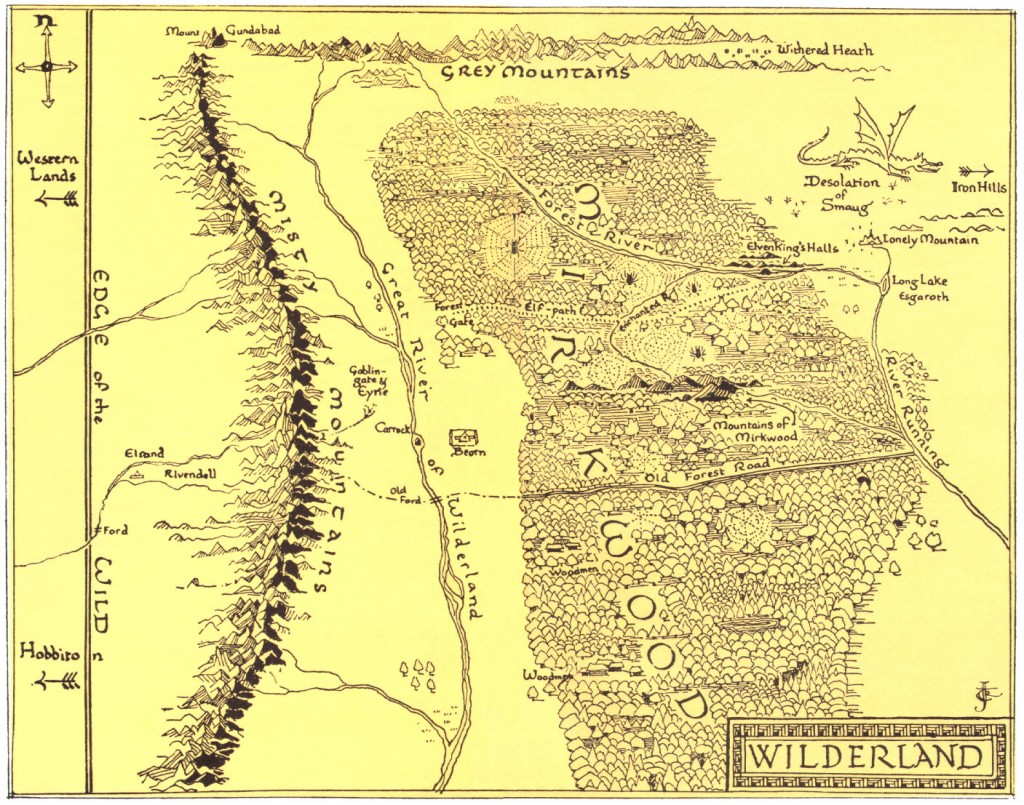 One of the most interesting aspects of the Map of Wilderland included in The Hobbit is that very odd, rather portentous demarcation denoting the “Edge of the Wild.” Perhaps many of us, as kids, did not really note the significance of this line: it remained, to us, an added piece of mystery and awe. Certainly, the line retains those qualities today. However, now that I am older, the real meaning of this line is clearer (and, yes, although the Professor may not have wanted us to search for any “meaning” in this line—but to take at its “face value,” rather—there is yet merit in analyzing it. It was drawn for a reason on the map, mind you). Well, perhaps it is not “meaning” for which we look in this line, but rather its purpose to us, the readers, as we follow Bilbo into the Wild.
One of the most interesting aspects of the Map of Wilderland included in The Hobbit is that very odd, rather portentous demarcation denoting the “Edge of the Wild.” Perhaps many of us, as kids, did not really note the significance of this line: it remained, to us, an added piece of mystery and awe. Certainly, the line retains those qualities today. However, now that I am older, the real meaning of this line is clearer (and, yes, although the Professor may not have wanted us to search for any “meaning” in this line—but to take at its “face value,” rather—there is yet merit in analyzing it. It was drawn for a reason on the map, mind you). Well, perhaps it is not “meaning” for which we look in this line, but rather its purpose to us, the readers, as we follow Bilbo into the Wild.
My interest in the Edge of the Wild peaked when I discovered a fantastic article by Patrick Brückner. In “Until the Dragon Comes,” Brückner focuses on the “real” and “fantastic,” and the reader’s perception of each, in Tolkien’s works; he notes that the mythopoeic role of dragons adds a “world-view that refers to an epic historic quality far beyond and different from the fairy tale elements of [Tolkien’s] texts” (Brückner 101). In the vernacular, Brückner merely posits that the concept of a dragon inherently adds realism to the text because of the historic properties we prescribe to dragons. I am not going to go on much more about archetypal dragons and their roles in mythopoeic fantasy; rather, I would like to focus on how Brückner applies this principle to uncover the true nature of the “Edge of the Wild” line.
Brückner notes, wisely, that it was Tolkien himself who, by virtue of adding this demarcation to the map, declared the point of transition from the “real” to the “fantastic” in The Hobbit. While it may seem a daunting task to argue against the Professor’s ostensible intent, Brückner provides a good case against this line being the actual point of transition. There are two reasons why this line does not mark a shift: first, because Rivendell (i.e., “the boundary of the perilous realm”) is clearly to the right of the line and, second, because the incident with the trolls occurs to the line’s left (109). Brückner’s thesis is, therefore, that we can assign the right side of the Edge of the Wild to the realistic sphere, and that we can do so because of the role of a dragon, Smaug (118). As a dragon, Brückner says, Smaug adds a “relevant epic-historical context that grounds The Hobbit“—the concept of the dragon inherently makes The Hobbit “a text that refers to older texts and traditions… that possess historical significance” (117). Thus, because Smaug exists to the right of the Edge of the Wild—and because his existence as a dragon carries with it the realistic sphere—this demarcation cannot be a point of transition from “real” to “fantastic.”
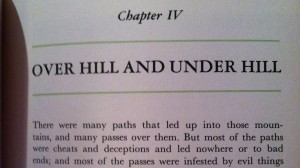 While I agree with Brückner’s conclusion, I cannot say it is only the dragon that adds realism to the story. Just as Smaug brings with him the “epic-historical” notions of dragons which ground him in the “real” sphere (think of dragons throughout Western literature, from Beowulf on), so too do the other “mythological” creatures in the text. Because of our now long exposure to Orcs, Elves, Wargs, and other rather fantastical inhabitants of Middle-earth, we attribute to them, too, the very same historical context as Brückner says we do to Smaug. One of the reasons we attribute such realism to the dragon is, as Brückner notes, that it references other texts. Well, with the wealth of literature written by Tolkien himself or about his works, the same references are possible with Orcs or any other creature. To fans of Tolkien’s works, Orcs and Dwarves are as “real” as Smaug; we simply use Tolkien’s legendarium as the historiographic source. Thus, to a fan to whom the question of Smaug’s existence is not an issue, neither is the assumption that the other ostensibly “fantastic” creatures to the right of the Edge of the Wild are actually real. It is, in my opinion, the collective picture painted by the inclusion of all these now familiar “fantastic” aspects (to which we ourselves assign historic—albeit not explicitly “real” historic—weight), that result in our placing the right side of the line in the sphere of realism.
While I agree with Brückner’s conclusion, I cannot say it is only the dragon that adds realism to the story. Just as Smaug brings with him the “epic-historical” notions of dragons which ground him in the “real” sphere (think of dragons throughout Western literature, from Beowulf on), so too do the other “mythological” creatures in the text. Because of our now long exposure to Orcs, Elves, Wargs, and other rather fantastical inhabitants of Middle-earth, we attribute to them, too, the very same historical context as Brückner says we do to Smaug. One of the reasons we attribute such realism to the dragon is, as Brückner notes, that it references other texts. Well, with the wealth of literature written by Tolkien himself or about his works, the same references are possible with Orcs or any other creature. To fans of Tolkien’s works, Orcs and Dwarves are as “real” as Smaug; we simply use Tolkien’s legendarium as the historiographic source. Thus, to a fan to whom the question of Smaug’s existence is not an issue, neither is the assumption that the other ostensibly “fantastic” creatures to the right of the Edge of the Wild are actually real. It is, in my opinion, the collective picture painted by the inclusion of all these now familiar “fantastic” aspects (to which we ourselves assign historic—albeit not explicitly “real” historic—weight), that result in our placing the right side of the line in the sphere of realism.
The most common sense case can be made for a demarcation placed East of Rivendell. The Misty Mountains mark the Western border of Rhovanion (Wilderland), so in that sense, such a line would really be the Edge of the Wild. However, that is of course not the case. So why, then, is the line placed where it is? The best scenario would be to ask the Professor himself (certainly this is one of those rather puzzling Middle-earth conundrums). Yet, I think I can fathom a guess, or at least one hypothesis. If you look at the Map of Wilderland, you’ll note that to the left of the demarcation, at the top, is written “Western Lands”, with an arrow naturally pointing West. If we hold Tolkien’s views on direction as canonical, then it makes sense for the East to be characterized as the “wild”, and altogether less fair than the West. Looking at a map of Eriador, such a conclusion seems plausible for, certainly, Wilderland lies far to the East.
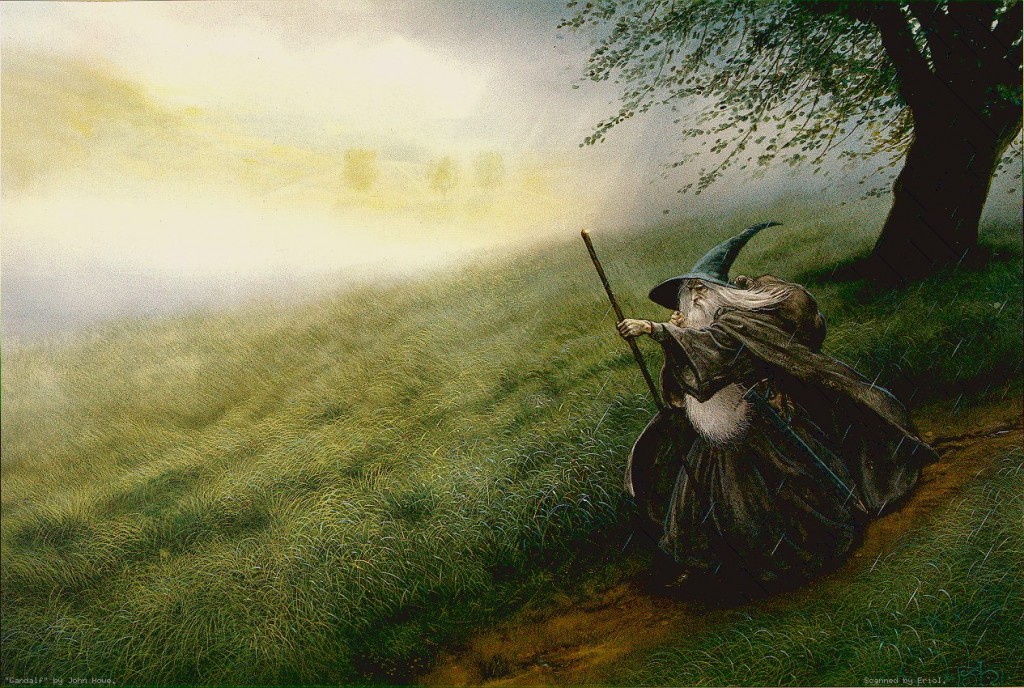 Though simple, such a hypothesis is sound; anyone familiar with Middle-earth knows that to the East lies danger. And the aforementioned simplicity is also key. When deciding to draw this now infamous line, Tolkien would probably not have been debating the convoluted significance of such an action—rather, he would have been thinking of geography, as any cartographer is wont to do. Unfortunately, we may never know.
Though simple, such a hypothesis is sound; anyone familiar with Middle-earth knows that to the East lies danger. And the aforementioned simplicity is also key. When deciding to draw this now infamous line, Tolkien would probably not have been debating the convoluted significance of such an action—rather, he would have been thinking of geography, as any cartographer is wont to do. Unfortunately, we may never know.
(All references to the text from: Brückner, Patrick. ” ‘…Until the Dragon Comes’: Tolkien’s Dragon-Motif as a Poetological Concept.” Tolkien’s Shorter Works: Essays of the Jena Conference 2007 (2008): 101-35. Walking Tree Publishers. Print.)
 We may be too late for his birthday in New Zealand, but it’s still his day in some parts of the world! Amidst all the hard work going on in New Zealand just now, the Hobbit gang found time to celebrate Ori’s birthday – and co-star Stephen Hunter tweeted this great photo of some of the cast gathered for birthday fun! (After TORn retweeted Stephen’s pic, James Nesbitt and John Callen retweeted us! We’re all connected on one great big web; just like the dwarves in Mirkwood…)
We may be too late for his birthday in New Zealand, but it’s still his day in some parts of the world! Amidst all the hard work going on in New Zealand just now, the Hobbit gang found time to celebrate Ori’s birthday – and co-star Stephen Hunter tweeted this great photo of some of the cast gathered for birthday fun! (After TORn retweeted Stephen’s pic, James Nesbitt and John Callen retweeted us! We’re all connected on one great big web; just like the dwarves in Mirkwood…)











